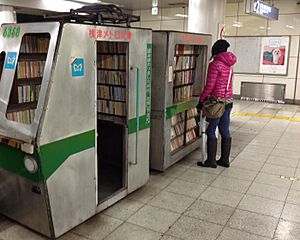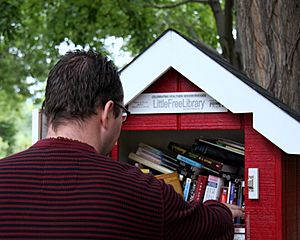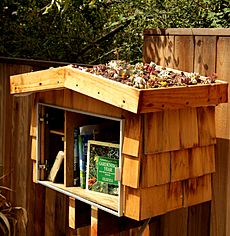Little Free Library facts for kids

A Little Free Library
|
|
| Founded | 2009 |
|---|---|
| Founder | Todd Bol |
| Type | 501(c)(3) nonprofit organization |
| Purpose | To be a catalyst for building community, inspiring readers, and expanding book access for all through a global network of volunteer-led Little Free Libraries. |
| Headquarters | [St. Paul, Minnesota]] |
| Greig Metzger | |
|
Revenue (2021)
|
$4,350,241 |
| Expenses (2021) | $3,489,818 |
|
Employees (2022)
|
13 |
|
Volunteers (2022)
|
60,000 |
Little Free Library is a special nonprofit organization. It helps people set up small book exchanges in their neighborhoods. These exchanges are often called Little Free Libraries.
More than 150,000 of these book exchanges are registered. They are in 115 countries around the world. Millions of books are shared each year. The main goal is to help everyone get books easily. The Little Free Library organization is based in St. Paul, Minnesota, USA.
Contents
How Little Free Libraries Started

The very first Little Free Library was built in 2009. It was made by Todd Bol in Hudson, Wisconsin. Todd built a small wooden box. It looked like a tiny schoolhouse. He put it on a post in his yard.
He filled it with books to honor his mother. She loved books and was a school teacher. Todd shared his idea with his friend, Rick Brooks. They built more bookhouses in the Midwestern United States. Soon, the idea began to spread everywhere.
Little Free Library became an official nonprofit organization in 2012. This meant it could get special support. Todd Bol had a big goal. He wanted to create 2,510 Little Libraries. This would be more than the libraries built by Andrew Carnegie. Carnegie was famous for building many libraries. Todd reached his goal in 2012.
The idea also became popular around the world. By 2016, there were 50,000 Little Free Libraries. They were in 85 different countries. A book was even written about the movement. Todd Bol passed away in 2018. Greig Metzger became the new leader in 2019.
Awards and Special Programs
The Little Free Library group has received many honors. They have been recognized by the National Book Foundation. The Library of Congress has also honored them. These awards are for their work. They help people learn to read and love books.
The organization uses money they raise for good causes.
- The Impact Library Program donates book exchanges.
- The Read in Color Program shares books that show different cultures.
- The Action Book Club combines reading with helping the community.
How a Little Free Library Works
It's simple to use a Little Free Library. Anyone walking by can take a book to read. They can also leave a book for someone else. Volunteers called "stewards" build and take care of these boxes.
To be an official Little Free Library, stewards buy a special sign. This sign has the "Little Free Library" name and a unique number. Registered libraries can be found on the Little Free Library World Map. This map shows where they are located. A free mobile app was also launched in 2022.
Little Free Libraries come in many shapes and sizes. Some look like small, colorful houses. Others might look like the TARDIS from Doctor Who! Most of them are in the United States.
Rules and Community Support
Most communities welcome Little Free Libraries. But sometimes, local rules can cause problems. These rules are called "zoning regulations." They say what can be built where. If problems happen, local governments often work with people to find solutions.
For example, in Whitefish Bay, Wisconsin, a rule stopped libraries in front yards. But later, the village changed its rules. They made a new rule that allowed Little Free Libraries on private property.
In Portland, Oregon, the mayor helped too. He changed city rules to allow community kiosks. This included Little Free Libraries. In Leawood, Kansas, a nine-year-old boy's library was stopped. His family started a Facebook page for support. The city council then allowed the libraries temporarily.
In Shreveport, Louisiana, a library was also shut down. City rules said libraries were only allowed in business areas. But the city council later changed the rules. They made it legal for book exchanges to be in neighborhoods.
Some people have pointed out that many Little Free Libraries are in wealthier areas. These places often already have good public libraries. They suggest that more libraries should be set up in neighborhoods where books are harder to get. The Little Free Library organization is helping to change old rules. They are showing that small, helpful projects like these should be allowed everywhere.
Little Free Pantries and Blessing Boxes
Little Free Libraries inspired other helpful projects. As of 2019, there were over 600 Little Free Pantries in the United States. They are also in Canada, the Netherlands, and Australia.
These pantries work like the libraries. Anyone can bring food, and anyone can take food. People also share things like soap and toothbrushes. The first Little Free Pantry opened in 2016 in Fayetteville, Arkansas.
Blessing Boxes are similar to Little Free Pantries. Churches often support them. They are places to share food and other useful items, like clothing. People are encouraged to "pay it forward." This means they donate what they can, like a can of beans. The idea is to help anyone who needs a little extra support.



